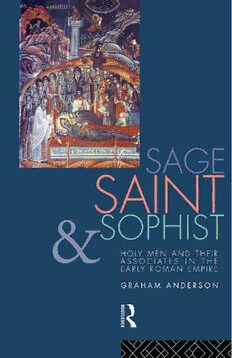
Sage, Saint & Sophist: Holy Men & Their Associates in the Early Roman Empire PDF
Preview Sage, Saint & Sophist: Holy Men & Their Associates in the Early Roman Empire
WEMINECYFs R O U T L Ee D G E SAGE, SAINT AND SOPHIST This page intentionally left blank SAGE, SAINT AND SOPHIST Holy men and their associates in the Early Roman Empire Graham Anderson London and New York First published 1994 by Routledge 2 Park Square, Milton Park, Abingdon, Oxon, OX14 4RN Simultaneously published in the USA and Canada by Routledge 270 Madison Ave, New York NY 10016 Transferred to Digital Printing 2006 © 1994 Graham Anderson Typeset in Garamond by Florencetype Limited, Kewstoke, Avon All rights reserved. No part of this book may be reprinted or reproduced or utilized in any form or by any electronic, mechanical, or other means, now known or hereafter invented, including photocopying and recording, or in any information storage or retrieval system, without permission in writing from the publishers. BritishL ibrary Cataloguingi n PublicationD ata A catalogue record for this book is available from the British Library. Library of CongressC atalogingi n PublicationD ata Applied for ISBN 0-415-02372-6 Front Cover illustration: The dormition of St Ephraim, Vaarlam Monastery, Meteora. Copyright © Stournaras, Kapaneos 72, 10444 Athens, Greece. Cover design: Gavin Joule Publisher's Note The publisher has gone to great lengths to ensure the quality of this reprint but points out that some imperfections in the original may be apparent For Alf and Margaret Smyth This page intentionally left blank CONTENTS Preface IX Abbreviations XI 1 CONCEPTS: THE HOLY MAN AND HIS MILIEUX 1 2 VIEWPOINTS: PERCEPTIONS AND PERSPECTIVES 16 3 PATTERNS: LIVES AND LIFESTYLES 34 4 WISDOM: CRAFTS, CUNNING, CREDULITY 54 5 ACCLAMATION: THE RHETORIC OF REVELATION 73 6 ACTION: DISPLAY AND INTERVENTION 86 7 ALLIANCE: DISCIPLES, CLIENTS, PATRONS 113 8 OPPOSITION: FALSE PROPHETS, CHEATS AND CHARLATANS 131 9 AUTHORITY: CAESARS, PRINCIPALITIES AND POWERS 151 10 TRAVEL: HOLY MEN ON THE MOVE 167 11 REPRESENTATION: THE HOLY MAN IN FICTION 178 12 PRESTIGE: THE ENHANCEMENT OF HOLINESS 188 CONTENTS 13 PROGRESS: CONTINUITIES AND COMPARISONS 198 14 EPILOGUE: VARIETIES OF AMBIGUITY 218 Appendix:J esus the Jew,·J esus the Magician 222 Notes 228 Select bibliography 270 Index 280 PREFACE This book sets out to study the careers and social relationships of an assortment of religious activists in the first three centuries of the Roman Empire. They range from familiar figures such as Jesus Christ and Apollonius of Tyana to the puzzling Peregrinus Proteus, who immolated himself after an Olympic Games, or the Secundus, who defied an emperor with an oath of silence. My object is to bring the climate of belief in these centuries more clearly within the framework of Roman social history. I have set out to examine what we can make out of the career patterns of holy men, their techniques of revelation and persuasion, their relations with patrons, populace and one another; and the growth of cults of individuals. In particu lar I have been interested in the overlap between a number of categories traditionally divided: the cultural environment of the period made it easy for doctor and medicine man to form part of a single spectrum; so do philosopher, religious antiquarian and ma gician, or Hellenic intellectual and oriental sage. The result is that most individuals are more complex than is allowed by the sources. Existing studies of holy men have emerged piecemeal, and an integrated view of their activities for the early Imperial period is lacking. Yet holy men were expected to advise on hygiene during an epidemic, sedate the local rapist, bring down the price of corn, or issue warnings to the Emperor. They were expected to command some brand of wisdom to enable them to make dramatic revel ations; and they required and exercised a 'publicity machine' of patrons and supporters to further their ends. The activities of such figures contributed to the climate in later antiquity in which theurgy eventually came to oust pagan philosophy, and monastic saints could take political initiatives. Holy men have remained too long on the fringe of Roman 'senatorial' history as colourful eccentrics and lX
